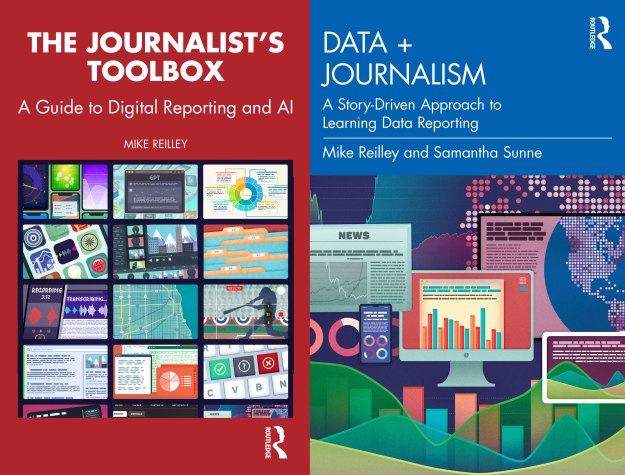
The Journalist’s Toolbox
A Guide to Digital Reporting and AI
Available on Routledge in December 2023. Visit the website | training videos | newsletter
Data + Journalism
A Story-Driven Approach to Learning Data Reporting
Available now on Routledge and Amazon. Check out a free bonus chapter on DEI and data on the blog.
ICFJ: ScholarAI: A Game-Changing Plug-In for ChatGPT
Quill magazine: Journalist’s Toolbox 25th Anniversary
GIJN: Google Earth Tools for Investigative Reporters
MediaShift EducationShift: Building a Mobile Newsroom
MediaShift EducationShift: Incorporating Data Journalism into Classes
————-
Columbia Journalism Review
Published January 2003 issue
Re-published with permission
Stalled CAR: Computer-Assisted Reporting — Journalism is still way behind
By Mike Reilley
A few years ago I met a teacher at Northwestern’s summer “Cherubs” program for high school journalists. He told me he bans his students from “playing” on the Web during class time. “They’re always looking something up online and not doing their work,” he grumbled.
My response: Have you ever taught them how to use an online database to find information on their school or community? Do they know where the city’s online “city server” is? Do they know how to look up state and federal legislation online? How to search for a publicly traded company’s proxy statement? How to use an expert database? Did he realize how valuable an online phone, e-mail, or map directory was to a young intern or reporter starting a job in a new community? His response: a blank stare.
In the September/October CJR, Harvard University’s John Lenger delivered an interesting and, sadly, true depiction of how students and young journalists rely too much on the Web for much of their research (“If a Tree Doesn’t Fall on the Internet, Does It Really Exist?” http://www.cjr.org/year/02/5/lenger.asp). But there is another problem, one that is not the students’ fault. Journalism professors, as well as newsroom leaders, need to climb the learning curve of this magnificent research tool, so that they can teach their students and staff not only when to go to the Web–and when not to–but how to maximize its reporting potential.
Twenty years ago journalists spent hours poring over campaign spending statistics because they didn’t have databases at sites such as OpenSecrets.org and CampaignFinance.org. Today, these research databases should be a part of any reporting course’s curriculum or any newsroom’s skills training program. Every reporter working the city desk should be trained in how to use these databases–whether they had training in college or not.
Sadly, many journalism schools are far behind the industry in teaching Web research, and the same is true for some newsrooms. Many schools focus on Web design and may only offer a computer-assisted reporting course as an elective. Meanwhile, basic reporting courses fail to show students how to read a spreadsheet or apply critical-thinking skills when evaluating Web content.
Thankfully, some journalism programs are keeping up with the times. For instance, as part of its new converged curriculum, the University of Southern California is weaving computer-assisted reporting into all its reporting classes. At Northwestern’s Medill School of Journalism, all undergraduate newspaper majors must take a C.A.R. course.
So what should professors be telling students? Treat the Web as another tool in their arsenal, same as they would a tape recorder, notebook, pen, public records office, an interview, or a trip to the library.
Showing students a few Web sites isn’t enough. Coach them through weekly research assignments using databases, spreadsheets, search engines, phone and e-mail directories, etc. Invite the local newspaper’s librarian to address the class, or tour the newspaper’s library and town hall records department. If you live in the same town as your state’s capitol, take your students over to the “bill room” and show them how to pull research on a referendum. Then show them what public-records databases can be found online–and which ones cannot.
Such activities could easily be adapted to a newsroom training program led by the staff’s C.A.R. expert, news librarian, and editors. Seminars could be organized into short weekly sessions or a weekend “boot camp,” depending on the time limitations of staff.
There’s much more high-quality information available today than ever before. Who would have thought, even ten years ago, that we could have instant access to summaries of local and federal legislation online, the ability to search newsgroups and story databases for obscure topics, and post a query on a Web site about a story idea? Today, you can use databases to track convicted sex offenders by county, city, and even zip code, a process that would have taken hours in the past. And municipal Web sites give access to contact information and police and fire statistics twenty-four hours a day, not just the eight hours or so that city hall is open.
As journalism educators and newsroom leaders, we’re responsible for teaching our students and professional colleagues to use this great resource to its fullest.
Mike Reilley, a former reporter and editor at the Los Angeles Times, was one of the founding editors of the Chicago Tribune’s Internet edition.